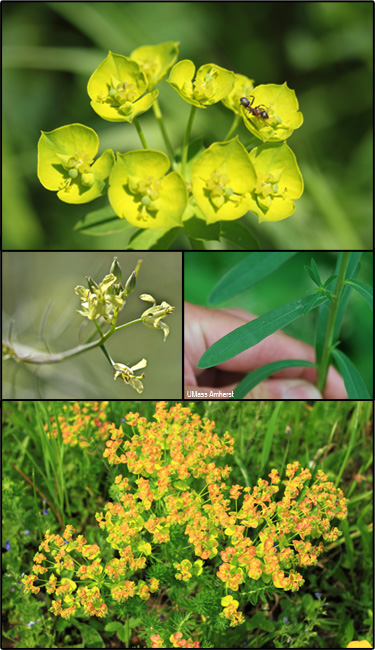Leafy spurge (Euphorbia virgata)
 Synonyms: Euphorbia esula
Synonyms: Euphorbia esulaCommon Names: Spurge
Description: This plant is native to Europe and Asia and was likely introduced to North America. This species is listed under Regulation No. 715 - Seed Law Implementation as a prohibited noxious weed by the Michigan Department of Agriculture.
Habit: Herbaceous perennial ranging in height from 15-92 cm (6-36 in); root system can extend up to 6 m (~20 ft).
Leaves: Simple, alternate, long, narrow, bluish green in color, usually pointed and drooping with smooth margins, exude white milky sap when crushed.
Stems: Upright stems that branch towards the top of the plant; dry stems may persist into the winter and following summer; stems also release white, milky sap when broken.
Flowers: Small, yellowish-green in color, fused petals form a cuplike structure; blooms mid-June through late-July.
Fruit and seeds: Smooth, oblong, gray-brown seeds in explosive capsules; one plant can produce up to 200 seeds; high germination rate; viable up to 8 years with adequate moisture.
Habitat: Roadsides, prairies, savannas, gravel pits, open areas.
Reproduction: By seed. Also spreads rapidly though its persistent root system from crown and root buds that over-winter under the soil surface.
Similar species: Flowering spurge (Euphorbia corollata) has white flowers and erect leaves; non-native Cypress spurge(Euphorbia cyparissias) has stem leaf blades less than 2.5 mm wide.
Monitoring and rapid response: Monitor open sites and woodland edges, early detection is critical. Leafs out early in spring; bright yellow-green bracts appear in late May or early June. Seedlings develop buds within 7-10 days of emergence. Long shoots spread laterally; pulling, digging, burning and tilling may cause them to increase. Foliar herbicide treatment provides effective control of small occurrences. Surveillance and control efforts needed for 5-10 years. Credits: The Michigan Natural Features Inventory (MNFI) has partnered with MISIN to provide the information in this fact sheet. Species images and/or information were used with permission from "A Field Identification Guide to Invasive Plants in Michigan's Natural Communities" and "A Field Guide to Invasive Plants of Aquatic and Wetland Habitats for Michigan.
Common Name: | Leafy spurge |
Scientific Name: | Euphorbia virgata |
Family: | Euphorbiaceae (Spurge) |
Duration: | Perennial |
Habit: | Herbs |
USDA Symbol: | EUES |
